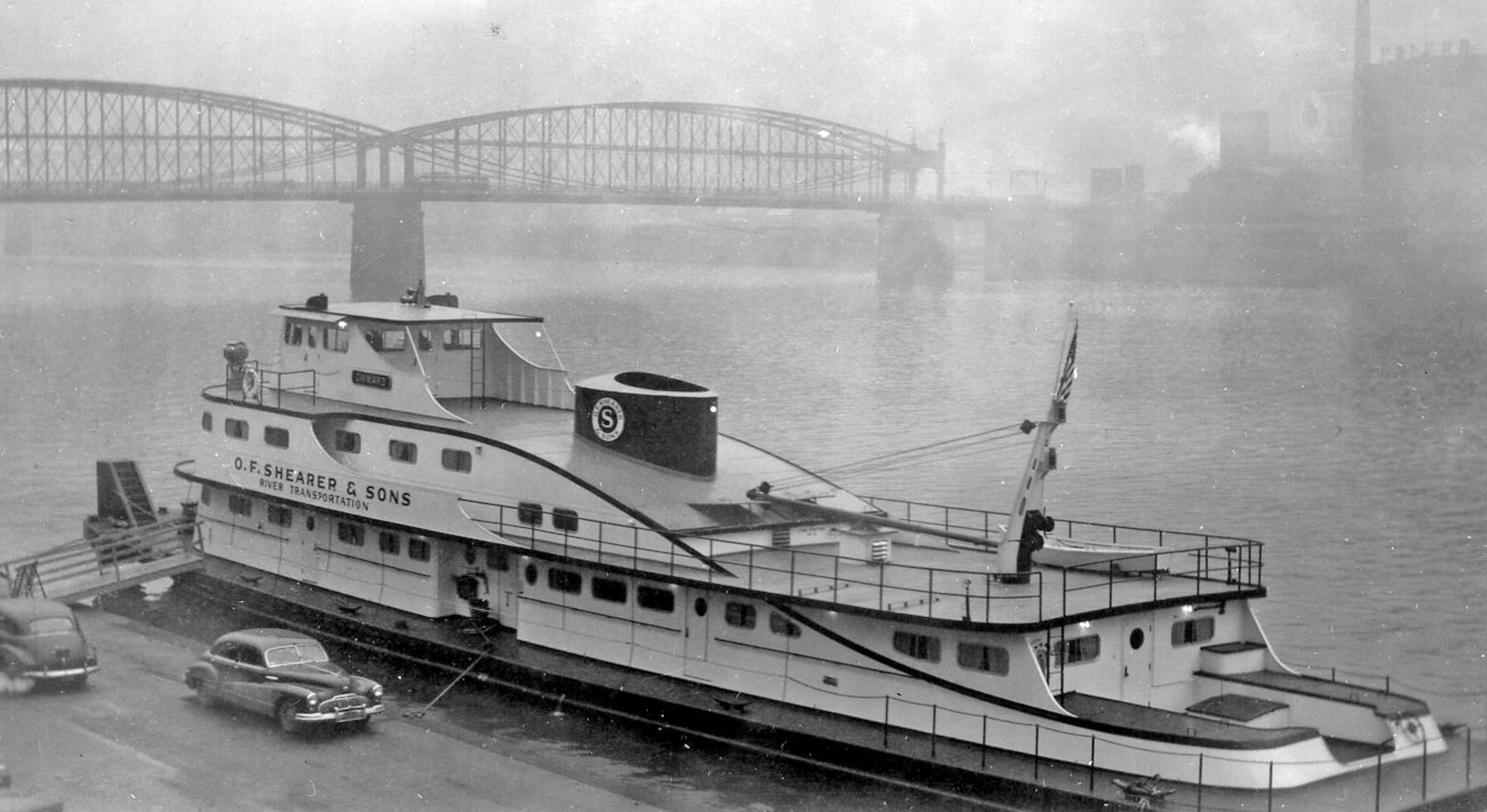In 1903, Pittsburgh Steel established a repair facility and machine shop on the left bank of the Monongahela River near Brownsville, Pa. In 1918, this property was purchased by John H. Hillman to repair floating stock of his Hillman Transportation Company. According to the Historic American Engineering Record, Hillman decided to move toward new vessel construction at Brownsville in the mid-1930s. Hillman Barge and Construction was the result, and it was set up under the direction of Capt. John L. Howder and Frank Silliman.
Hillman Barge first built barges, but, after World War II, John Hillman wanted to build towboats. These were not just run-of-the-mill towboats but something that looked completely different from those turned out by other shipyards. In 1945, he convinced marine engineer/architect Elmer Easter to leave Dravo Corporation and come to Hillman to design and build these unique towboats. The vessels that Easter designed had sheer and camber built into the hull and decks, curved plating on the cabin bulkheads, “S” shaped contours to the roof and the engines placed mid-ship.
A prototype vessel was built for a Pittsburgh firm in 1946, and in 1947 the truly refined and streamlined Hillman towboats began sliding down the ways. The first was the Solvay, built for the Semet-Solvay Division of Allied Chemical, Ashland, Ky. In describing this boat, The Waterways Journal noted that it “is a distinct departure from previous industry designs and methods.” The Solvay was closely followed by the La Belle for Wheeling Steel Corporation, and then the last for 1947 was the boat that is the subject for this week.
O.F. Shearer & Sons River Transportation began with Capt. O.F. Shearer operating small sternwheel gas boats and later diesel craft on the Kentucky River in the second decade of the 20th century. His two elder sons, Capts. Oliver and Bert Shearer, were born on these small towboats and were piloting them by the time they were in their teens. The company grew with the addition of larger boats, some of which were built by the Shearers or rebuilt to diesel from steam. In 1939, the steam sternwheel Victory was purchased and renamed O.F. Shearer. There were five diesel boats in addition to this when the company took delivery of the new Hillman boat.
The new boat was named Onward and had a hull that was 145 feet by 28 feet. It was powered by two GM diesels totaling 1,400 hp. with Falk gears and air-flex clutches. The 72-inch propellers turned in kort nozzles that increased thrust. A newspaper article detailed the craft’s first arrival at Cincinnati, after traveling from the Hillman yard to Cedar Grove, W.Va. on the Kanawha River, where it picked up a tow of 16 coal loads for delivery to the Cincinnati area. The piece referred to the Onward as a riverman’s “dreamboat” and stated that it had cost $450,000. Capt. O.F. was aboard for the initial trip, as were Oliver and Bert. Capt. Bert was to be the regular master of the vessel.
Within a very short time, the Onward was sold to The Ohio River Company (Orco). In responding to a question about this sale many years later, Capt. Bert Shearer indicated that they were able to realize a good profit by it, though he said, “I was on that new boat with all that power, and then they sold it out from under me, and I had to go back to the Duncan Bruce.” Of course, the “they” would have included him since he was one of the owners!

The 1948 edition of the Inland River Record incorrectly listed the new name for the boat as R.W. Lea. It had actually been renamed Robert W. Lea. The 1948 IRR did state that “R.W. Lea, Esq. is former president of Orco and present head of Johns-Manville Corporation.” Orco utilized the Lea on the Ohio and Illinois rivers until it was sold to Riverways Corporation, Cape Girardeau, Mo., in 1965 and renamed Flagship. In September 1970, it was sold to South Point (Ohio) Barge Company and named Mike J. In May 1971, it was sold to Madison Coal & Supply, Charleston, W.Va., and renamed Charleston.
Capt. Jim Lilly was the master of the newly renamed Charleston, with his son, Capt. Bo Lilly, as pilot and relief master. In 1975, it was repowered with a pair of Cat D398 engines and Cat 4.22:1 gears that totaled 1,700 hp. It was again repowered in 1997 with Cat 3512 engines of 2,400 hp. For the past 54 years, this boat has remained a mainstay for the company, which became Amherst Madison, Inc. in 2010.
While the other boats in this 145-foot-long Hillman class have been scrapped or sold foreign, the Charleston continues to turn heads wherever it goes, just as it did when new 78 years ago. It is always kept in the best condition, inside and out, and maintains a reputation as a very smooth vessel to those that work on it.
Those familiar with the history of ocean liners may recall that the RMS Aquitania, built for Cunard in 1914 and in service until 1950, carried a nickname of “The Ship Beautiful.” Watching the sleek Charleston glide by on any river today, one would be hard pressed to say that she is anything but “The Towboat Beautiful.”
————
Featured photo caption: The new Onward on January 12, 1948, at Pittsburgh, Pa. (From the Dan Owen Boat Photo Museum collection)




